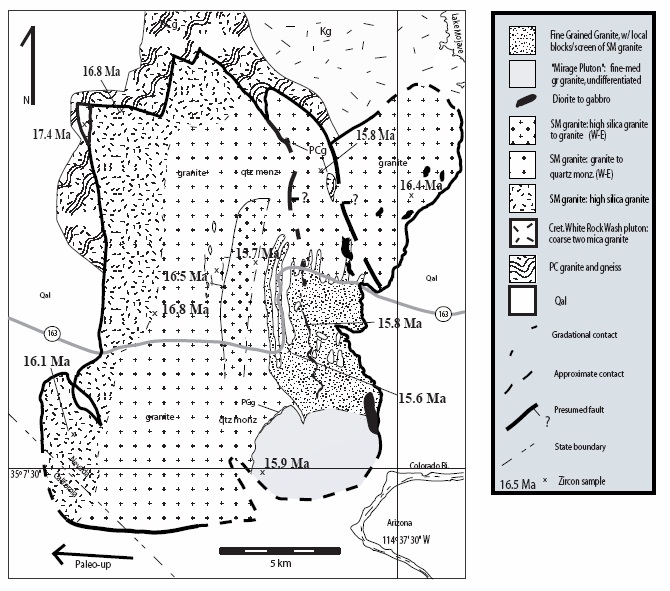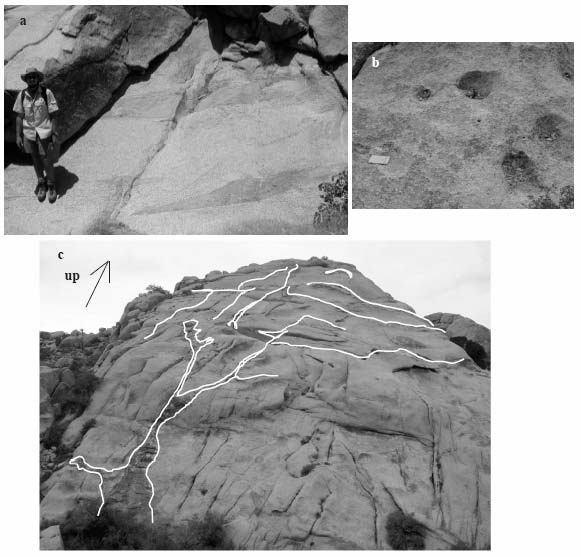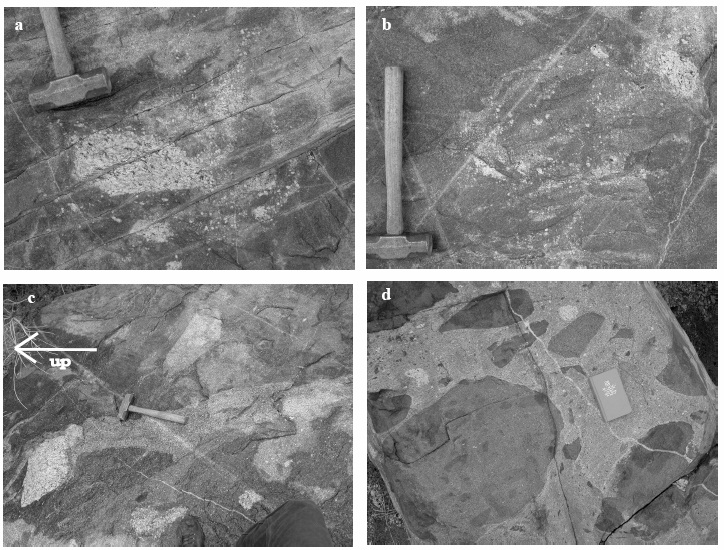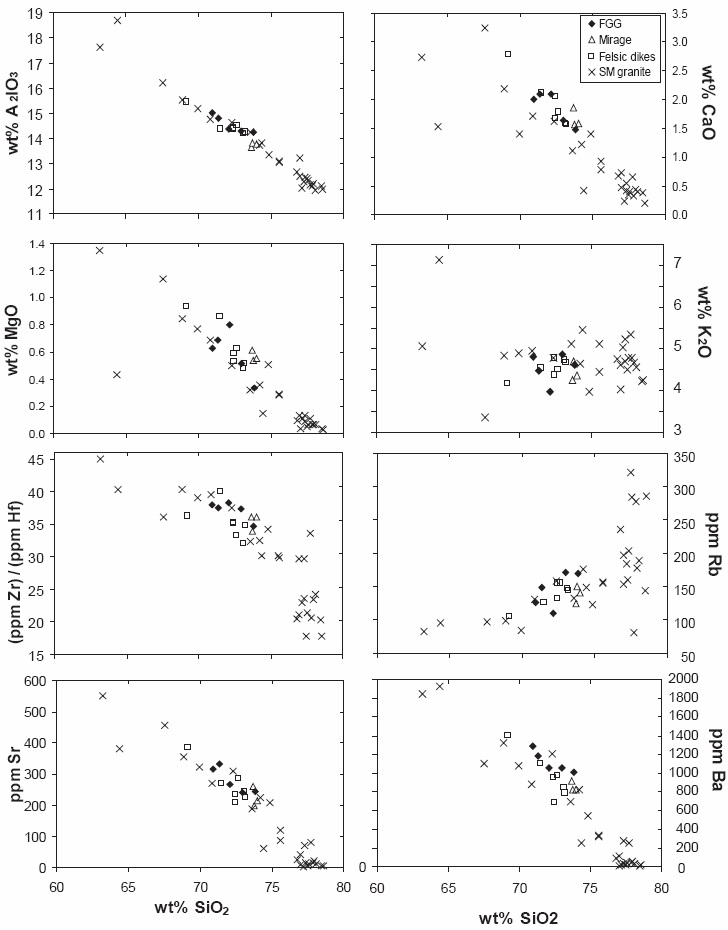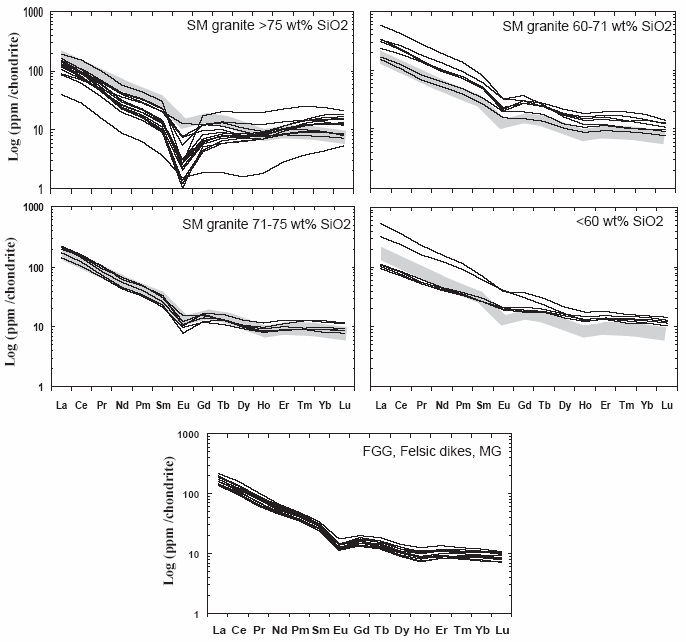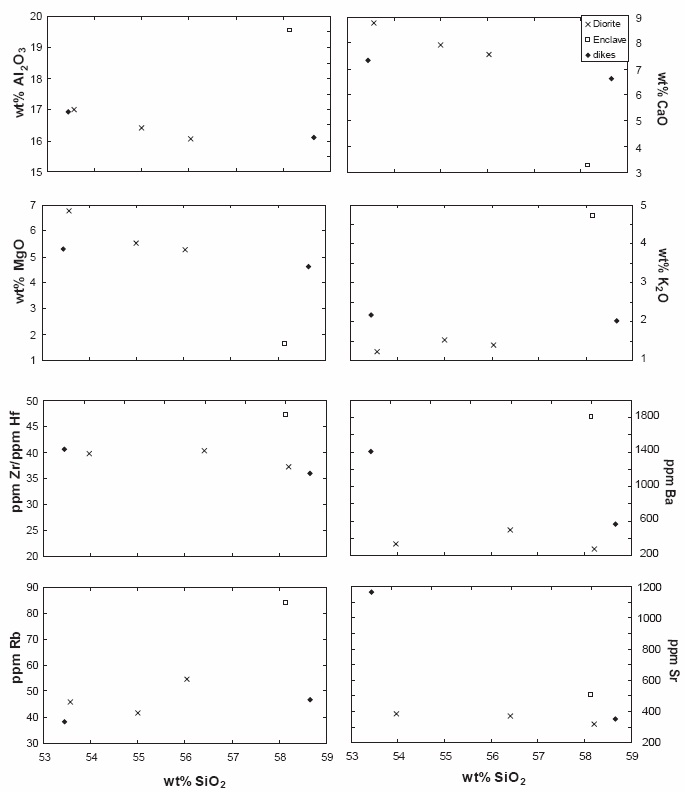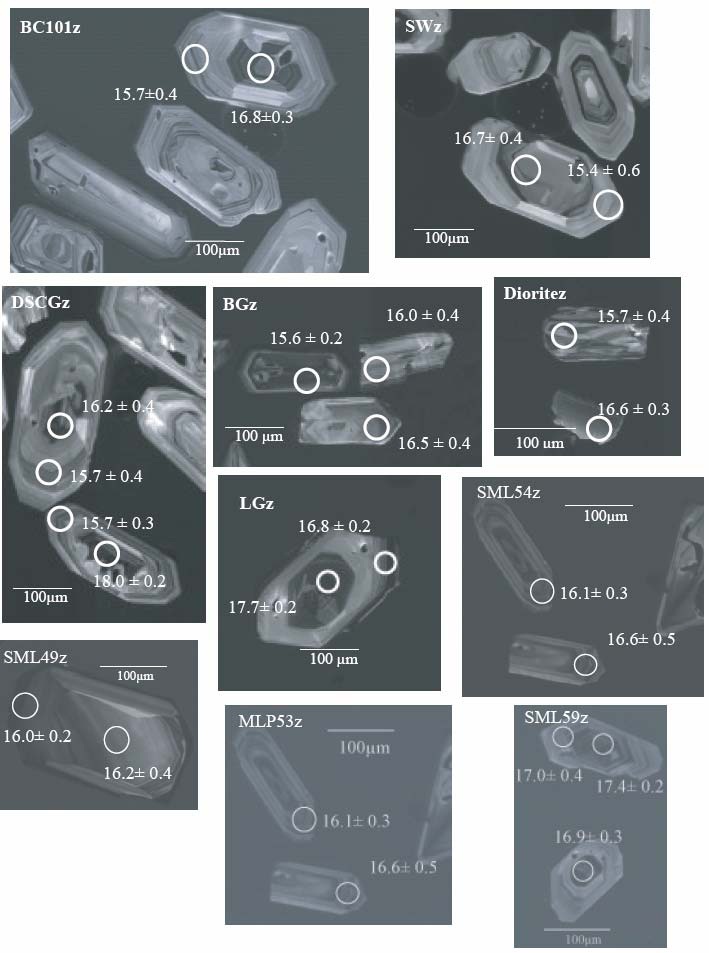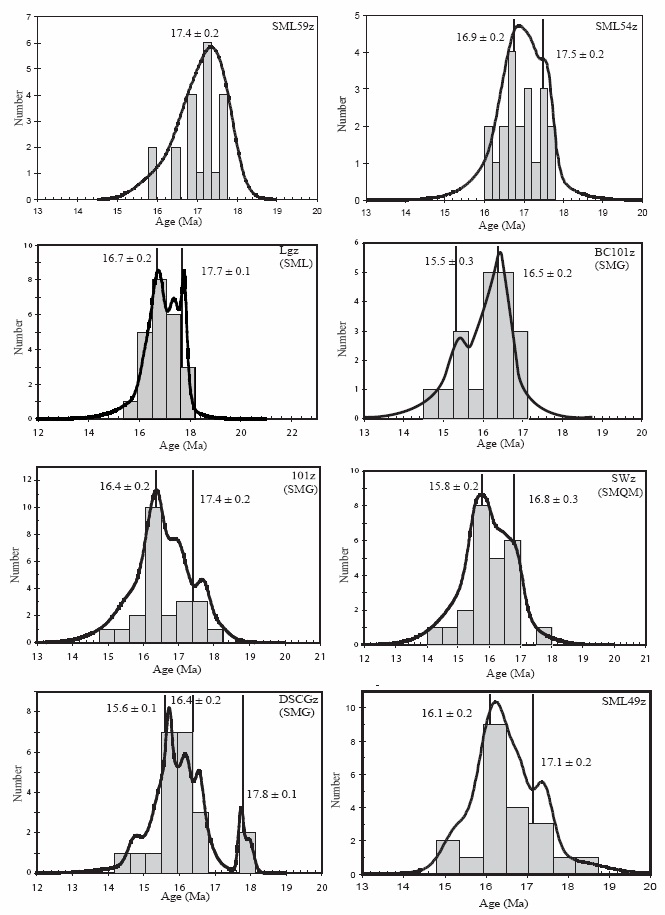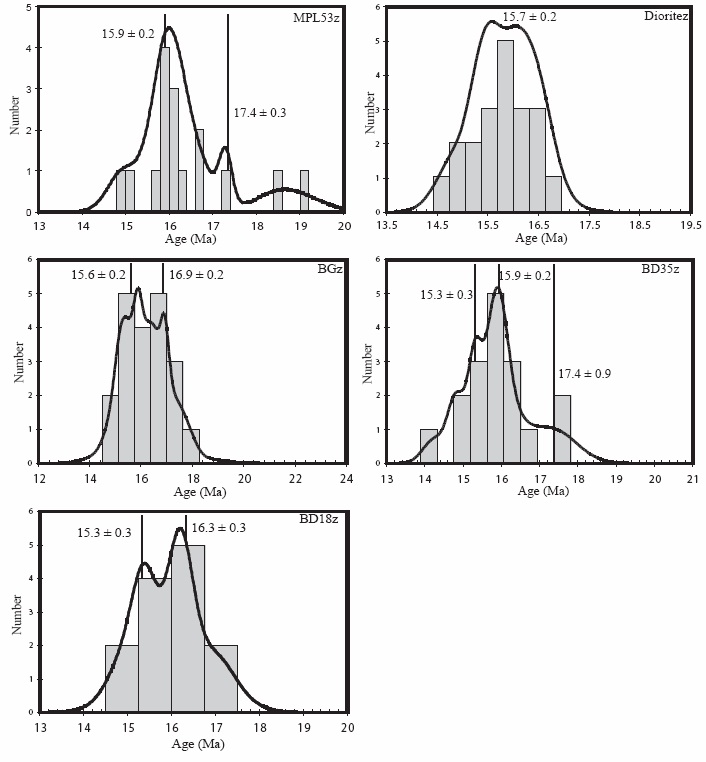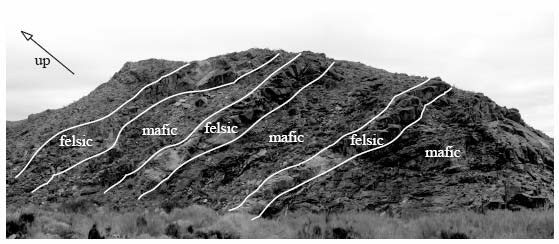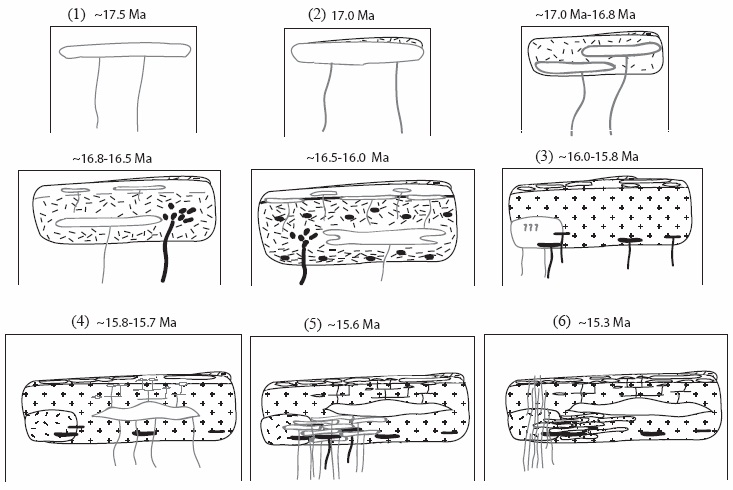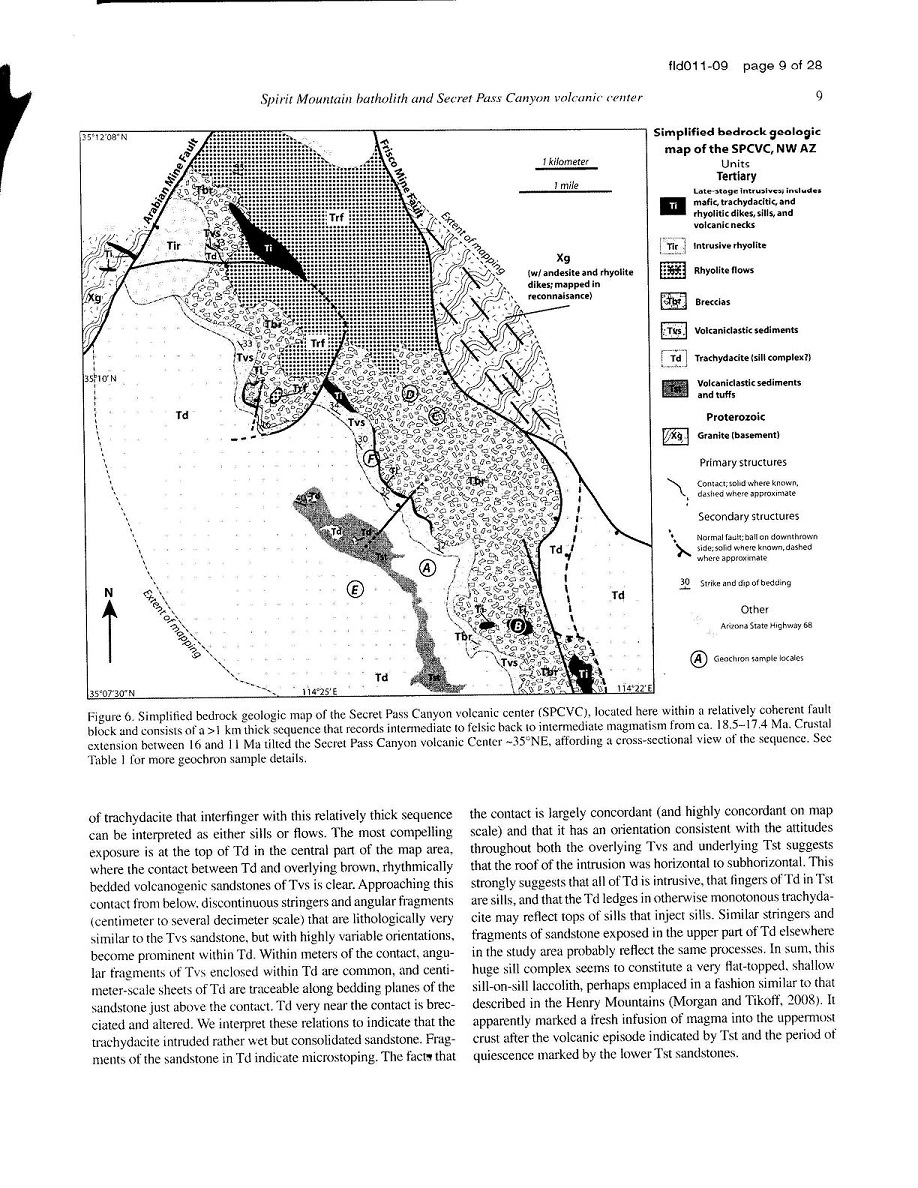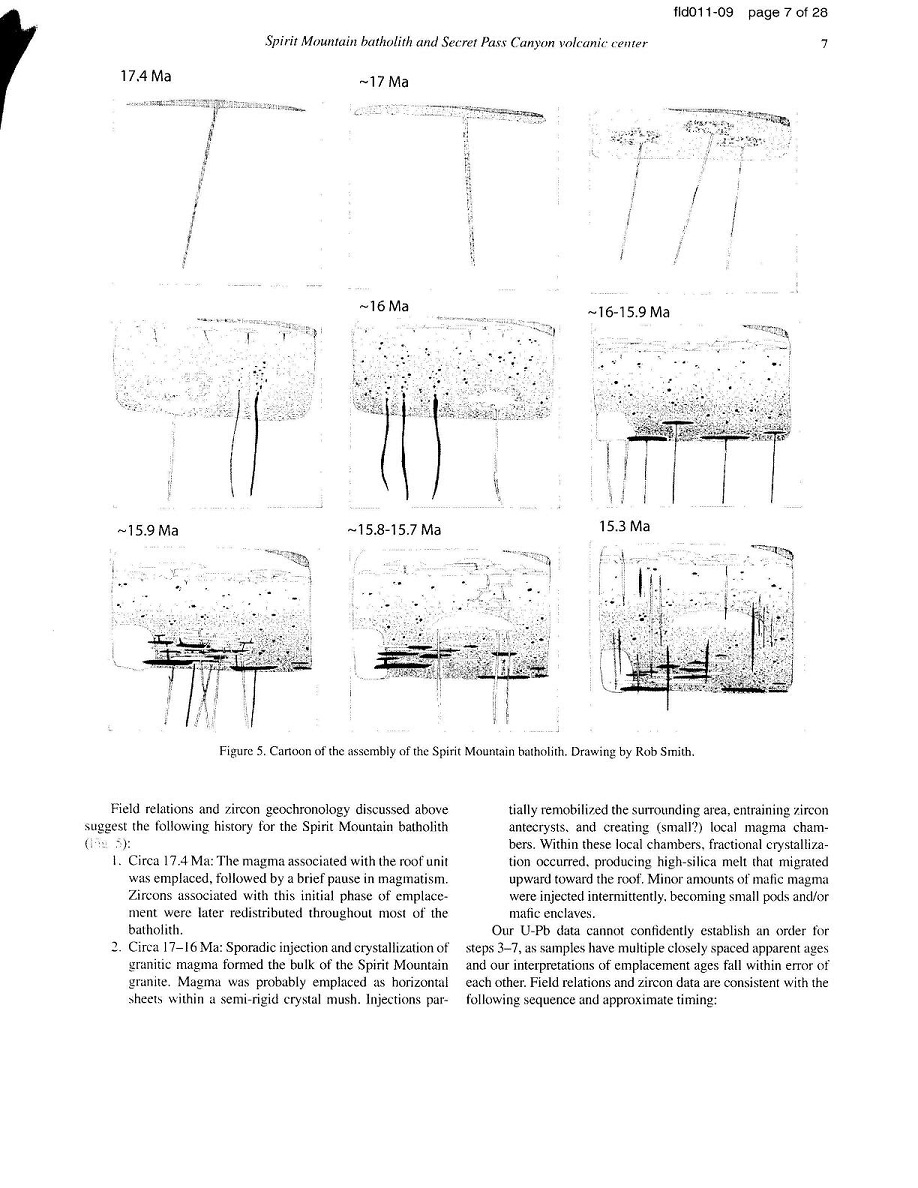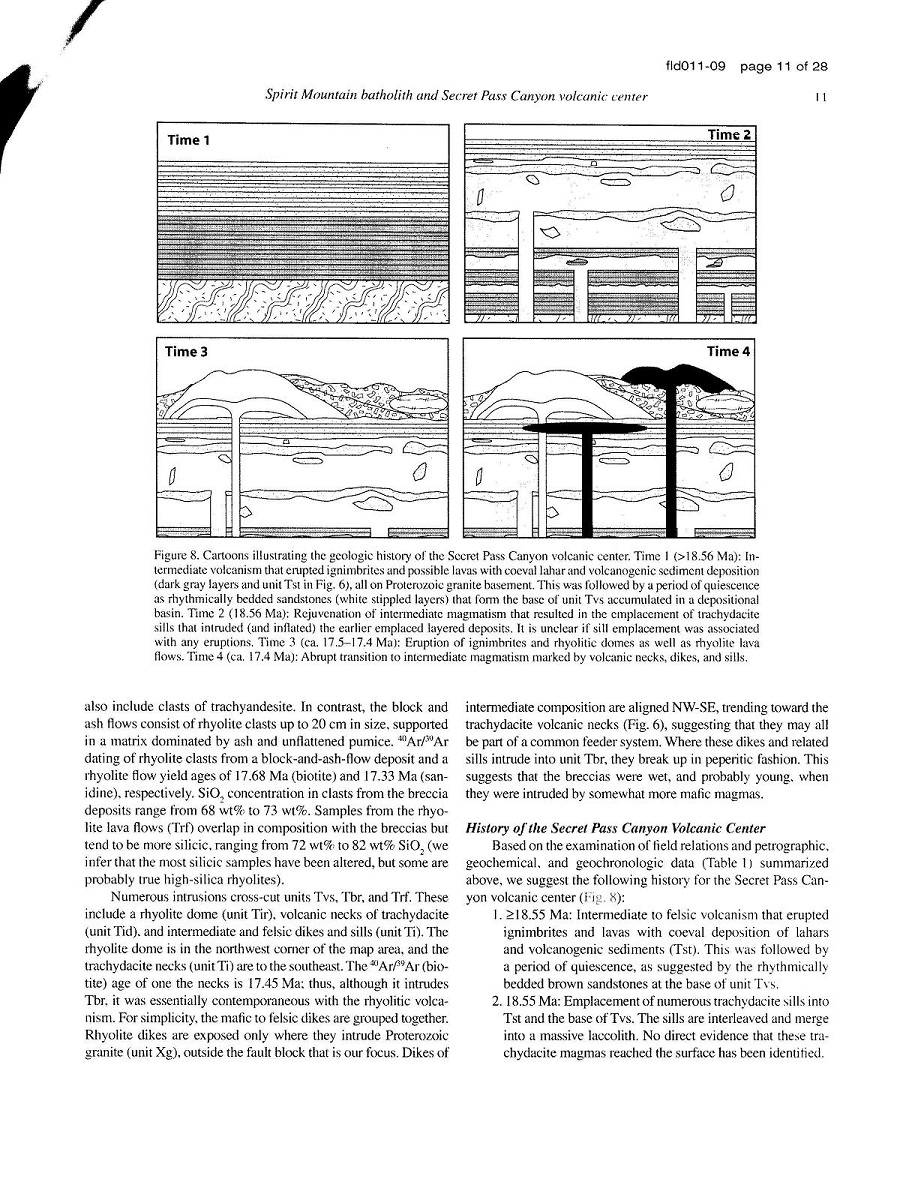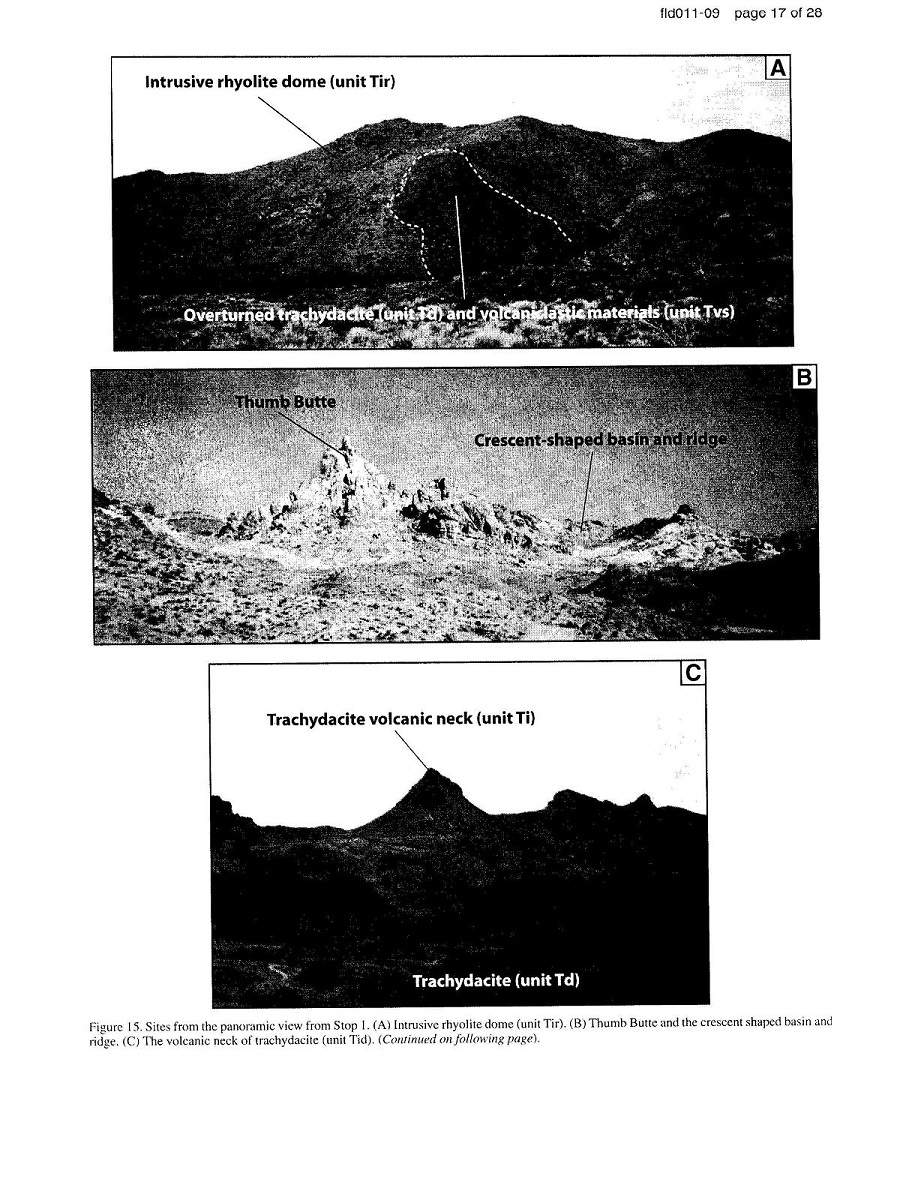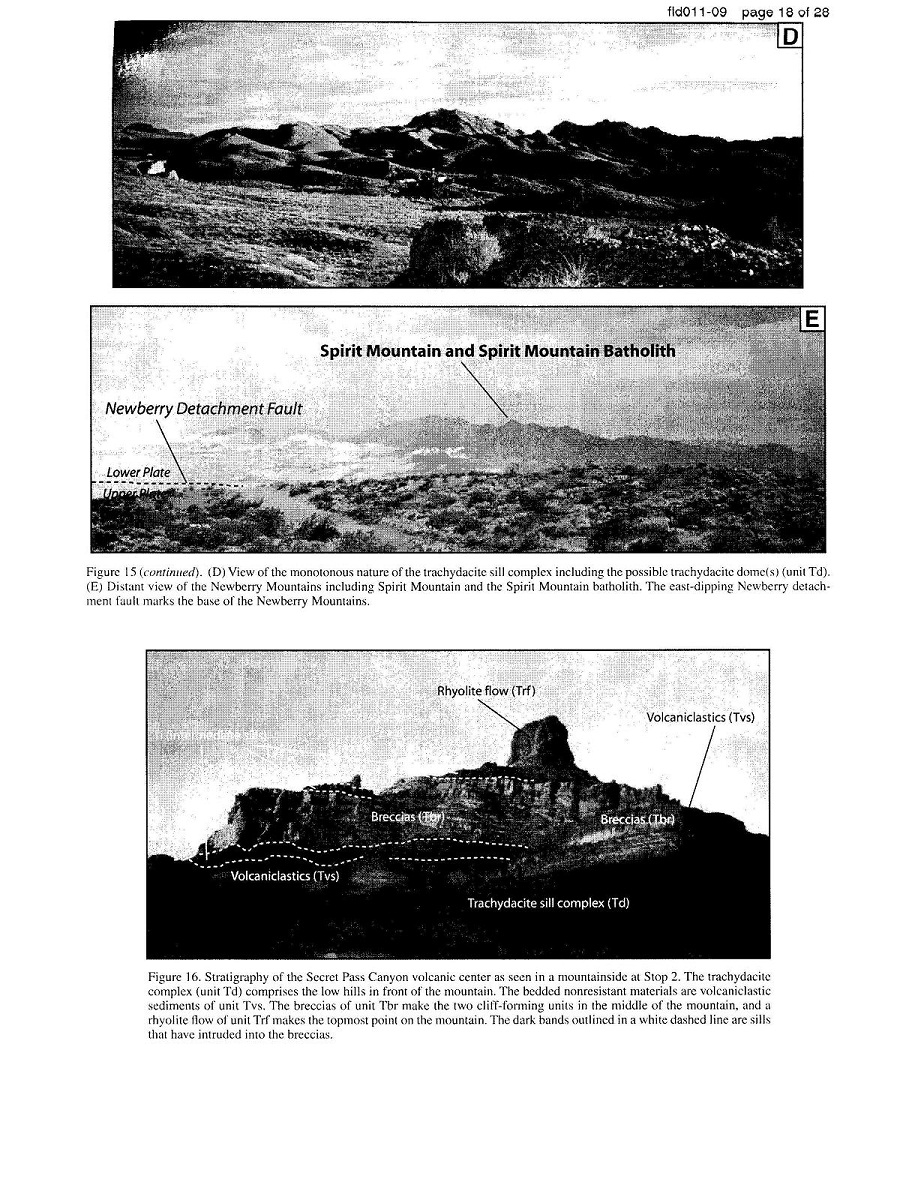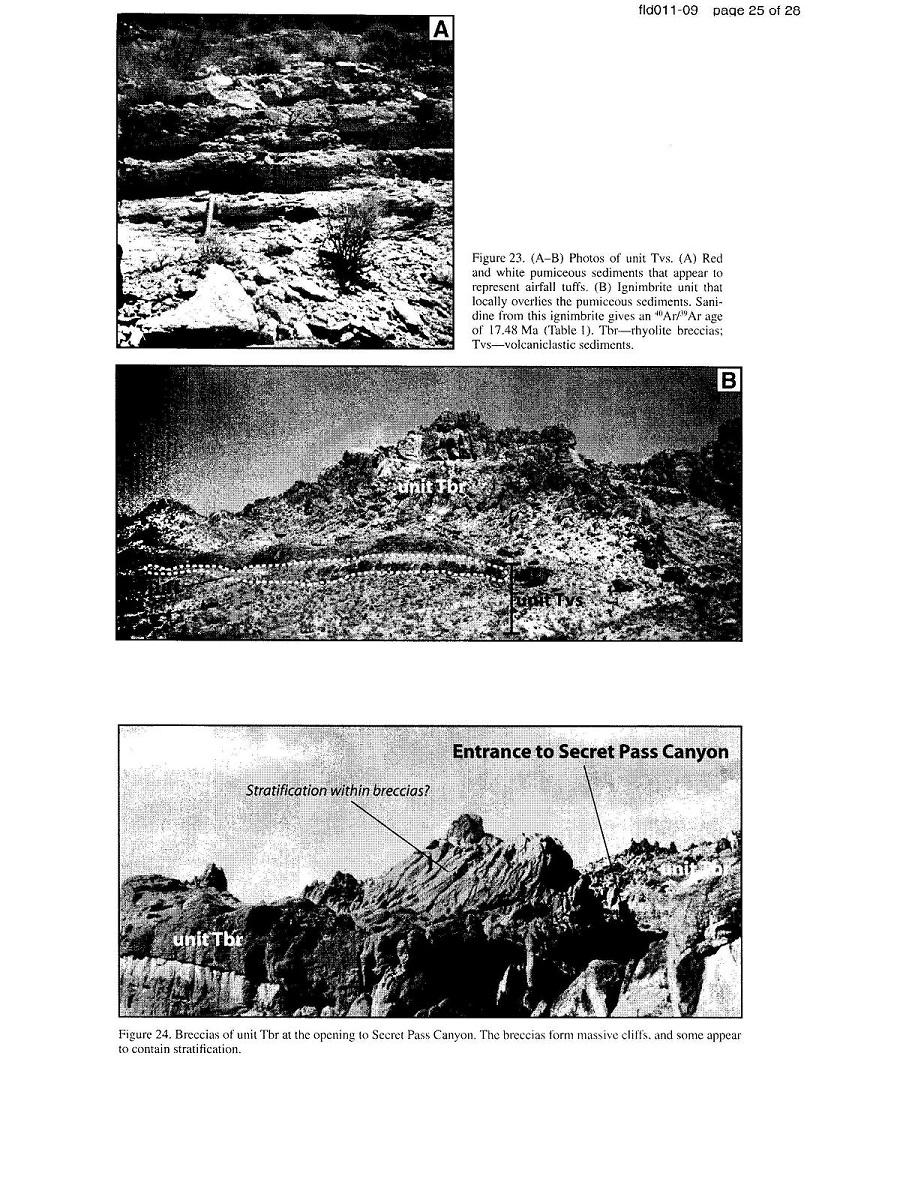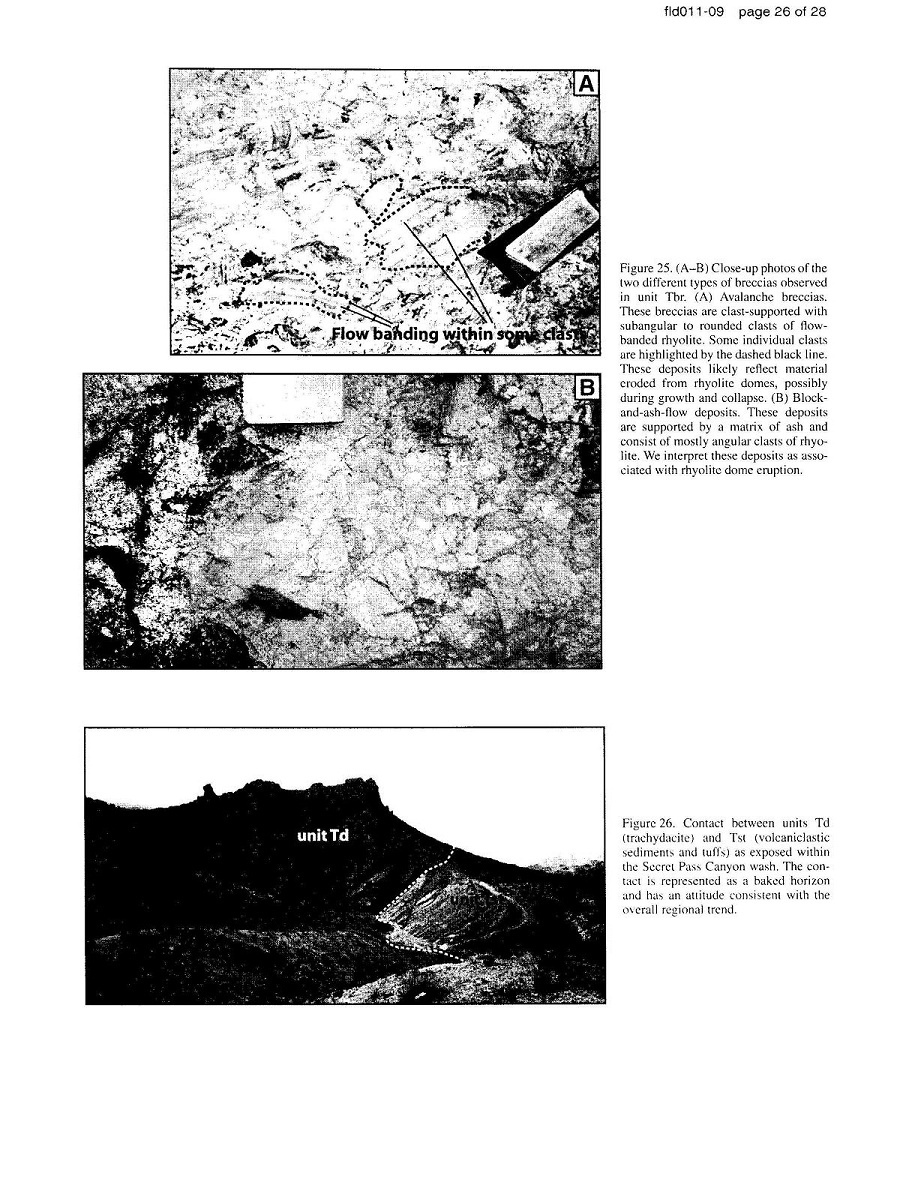 | Батолит Горы Духов Spirit Mountain batholith |
|
|
(a) Large, pancake-shaped mafic enclaves within the SM quartz monzonite.Enclaves are aligned parallel to the host’s foliation. 5’9” Ben George for scale.(b) Large quartzofeldspathic cavities within the SM leucogranite. (c) A network of leucogranite dikes and sills within the SM granite. Paleo-up direction indicated |
(a) A xenolith of SM granite within the diorite. Poorly defined margins of the xenolith and large feldspar crystals in the diorite suggest this xenolith was partially disaggregated. (b) A loose collection of feldspar crystals within a contaminated diorite perhaps documenting the final stages of xenoliths disaggregation. (c) A SM granite xenolith with a tail of feldspar-bearing,contaminated diorite, possibly documenting the frozen process of a xenoliths sinking (or floating) in the diorite. (d) Contaminated dioritic pillows within a contaminated fine-grained granite (FGG). Note also the small, white xenoliths of the SM granite |
Harker diagrams for selected major element oxides and trace elements of SMB |
Chondrite normalized rare earth element patterns for the SMB samples,separated as indicated. The field for FGG, felsic dikes, and MG is shaded for comparison to the SM granite and mafic samples |
Harker diagrams for selected major element oxides and trace elements of SMB |
Cathodoluminescence images of SMB zircons from various samples. Ages are in Ma, and are 206Pb/238U. Errors are 2 sigma. Circles show approximate spot size and location |
Probability density plots of SMB zircon samples. Vertical lines behind histograms indicate age populations, each of which is labeled with a date that was established by UNMIX (after Sambridge and Compston, 1994) in Isoplot.SML—leucogranite. SMG—granite. SMQM—quartz monzonite |
Continued. Probability density plots of SMB zircon samples. Vertical lines behind istograms indicate age populations, each of which is labeled with a date that was established by UNMIX (after Sambridge and Compston, 1994) inIsoplot. MPL—Mirage pluton. BGz—fine-grained granite. BD—felsic dikes |
Successively stacked fine-grained granite (FGG) sills intruded into diorite.This sill-on-sill geometry is observed throughout the FGG and diorite units.For scale, the FGG sills are ~5m thick. Initial up direction is indicated |
Assembly cartoon for the Spirit Mountain batholith. |
Secret Pass Canyon volcanic centerfrom http://math.mercyhurst.edu/~nlang/assets/publications/gsafg11_lang.pdf |
Secret Pass Canyon volcanic center from Nicholas P. Lang http://math.mercyhurst.edu/~nlang/assets/publications/gsafg11_lang.pdf |
Secret Pass Canyon volcanic center from http://math.mercyhurst.edu/~nlang/assets/publications/gsafg11_lang.pdf |
Secret Pass Canyon volcanic center from http://math.mercyhurst.edu/~nlang/assets/publications/gsafg11_lang.pdf |
Secret Pass Canyon volcanic center from Nicholas P. Lang http://math.mercyhurst.edu/~nlang/assets/publications/gsafg11_lang.pdf |
Secret Pass Canyon volcanic center from Nicholas P. Lang http://math.mercyhurst.edu/~nlang/assets/publications/gsafg11_lang.pdf |
Secret Pass Canyon volcanic center from Nicholas P. Lang http://math.mercyhurst.edu/~nlang/assets/publications/gsafg11_lang.pdf |
From http://math.mercyhurst.edu/~nlang/research/
Батолит Горы Духов (Spirit Mountain batholith -SMB) - гранитный комплекс в южной Неваде. Он появился 18-15.5 МА. Проявилось растяжение коры, ее утончение и наклон (tilting) батолита на 45 градусов на запад. В результате корового наклона (tilting), мы имеем то, что имеем- батолита на карте имеет 5 - 10 км палеоглубины. На вершине батолита доминируют высоко кварцевые лейкограниты, которые постепенно переходят в гранит на глубине и кварцевый монзонит (quartz monzonite) на еще больших глубинах. Эта композиционная градация сопровождается изменением текстуры, увеличеннием фолиации и более обильными "мафическими" (базальт-андезит) анклавами на глубине. В дополнение к этим анклавам, есть довольно значительные габбровые до диоритовых тела, обнаженные в более глубокой части батолита.
Базируясь на цирконовой геохронологии, можно утверждать что история происхождения батолита включает повторные инъекции гранитных партий (batches) магмы в верхнюю кору. В течение формирования эти партии частично кристаллизовались (плагиоклаз, роговая обманка, биотит, сфен, Fe-Ti окиси и немного щелочных полевых шпатов и кварца). Остатки расплавов, мигрируя к вершине батолита, по мере охлаждения формировали прослои обогащенного кварцем лейкогранита, что мы и видим в SMB. Большой внутренний "плутон" внутри батолита имеет лейкогранитную вершину, от которой отходят сети лейкогранитных даек и силлов внутрь гранитов. Этот процесс повторной инъекции магмы, fractionation, переплавления, сегрегации, кажется, ключевой игрок в строительстве большинства SMB. Последние инъекции сохранены как вертикальные дайки. Это изменение геометрии тел магмы возможно сопровождало региональные тенденции.
1) ~17.4 Ma: The magma associated with the roof unit (SML59z) was
emplaced, followed by a pause in magmatism. Zircons associated with this
initial phase of emplacement were later redistributed throughout most of the
batholith.
2) ~17-16 Ma: Sporadic injection and crystallization of granitic magma formed
the bulk of the SM granite. Magma was probably emplaced as horizontal
sheets within a semi-rigid crystal mush. Injections partially remobilized the
surrounding area, entraining zircon antecrysts, and creating (small?) local
magma chambers. Within these local chambers, fractional crystallization
occurred, producing high-silica melt which migrated upward towards the roof.
Minor amounts of mafic magma were injected intermittently, becoming small
pods and/or mafic enclaves.
(Geochronology alone cannot accurately establish an order of steps 3-6, as
events fall within error of each other. Field relations and zircon data are
consistent with the following sequence and approximate timing.)
3) ~16.0-15.8 Ma: The Mirage granite intruded, probably in sheet by sheet
fashion. Fractional crystallization of this magma produced a leucocratic roof
zone, similar to but much smaller than that of the SM granite. Injections of
basaltic-dioritic magma formed horizontal sheets and pods that cut the SM
granite and were in part coeval with the Mirage granite.
4) ~15.8-15.7 Ma: Magma continued to be injected into the SM granite, which
had effectively solidified by this time, to produce the distinct, younger
sequence. Fractional crystallization again produced high-silica melt which
accumulated at the roof zone of this intrusion. Some of this fractionated melt
debouched from the intra-batholith cupola, upward into the overlying granite.
A preserved network of leucogranite dikes, sills, and pods document the
ascent pathways and ponding zones of this material. This magma addition
probably provided enough heat to the surrounding granite (mush?) to dissolve
zircons (+ other minerals?) and grow new rims in situ.
5) ~15.6 Ma: FGG was emplaced as a series of successively stacked, horizontal
sheets. Cooling of this injection was probably relatively rapid, as suggested
40
by the fine grained texture. Minor mafic-dioritic magma emplacement
continued through this time, as well.
6) ~15.3 Ma: Termination of SMB magmatism was marked by injection of a
series of vertically intruded, felsic to mafic dikes. Emplacement of the
Newberry dike swarm followed final solidification of the remainder of the
batholith and may have been facilitated by the onset of rapid E-W extension
(George et al., 2005), which is suggested to have occurred ~15.5-16.0 Ma
(Faulds et al., 2001).
from http://etd.library.vanderbilt.edu/available/etd-04032006-125301/unrestricted/Walker_Master_Thesis.pdf

